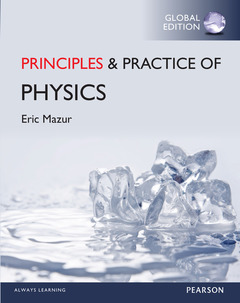Description
Principles of Physics (Chapters 1-34), Global Edition
Author: Mazur Eric
Language: English
Subject for Principles of Physics (Chapters 1-34), Global Edition:
1072 p. · 22x27.6 cm · Paperback
Description
/li>Contents
/li>Comment
/li>
For Introductory Calculus-based Physics Courses.
Putting physics first
Based on his storied research and teaching, Eric Mazur?s Principles & Practice of Physics builds an understanding of physics that is both thorough and accessible. Unique organization and pedagogy allow students to develop a true conceptual understanding of physics alongside the quantitative skills needed in the course.
- New learning architecture: The book is structured to help students learn physics in an organized way that encourages comprehension and reduces distraction.
- Physics on a contemporary foundation: Traditional texts delay the introduction of ideas that we now see as unifying and foundational. This text builds physics on those unifying foundations, helping students to develop an understanding that is stronger, deeper, and fundamentally simpler.
- Research-based instruction: This text uses a range of research-based instructional techniques to teach physics in the most effective manner possible.
This program provides a better teaching and learning experience for you and your students. Here?s how:
- Build an integrated, conceptual understanding of physics: Help students gain a deeper understanding of the unified laws that govern our physical world through the innovative chapter structure and pioneering table of contents.
- Encourage informed problem solving: The separate Practice Volume empowers students to reason more effectively and better solve problems.
- Personalize learning with MasteringPhysics: MasteringPhysics provides students with engaging experiences that coach them through physics with specific wrong-answer feedback, hints, and a wide variety of educationally effective content.
- 1. Foundations
- 2. Motion in One Dimension
- 3. Acceleration
- 4. Momentum
- 5. Energy
- 6. Principle of Relativity
- 7. Interactions
- 8. Force
- 9. Work
- 10. Motion in a Plane
- 11. Motion in a Circle
- 12. Torque
- 13. Gravity
- 14. Special Relativity
- 15. Periodic Motion
- 16. Waves in One Dimension
- 17. Waves in Two and Three Dimensions
- 18. Fluids
- 19. Entropy
- 20. Energy Transferred Thermally
- 21. Degradation of Energy
- 22. Electric Interactions
- 23. The Electric Field
- 24. Gauss’s Law
- 25. Work and Energy in Electrostatics
- 26. Charge Separation and Storage
- 27. Magnetic Interactions
- 28. Magnetic Fields of Charged Particles in Motion
- 29. Changing Magnetic Fields
- 30. Changing Electric Fields
- 31. Electric Circuits
- 32. Electronics
- 33. Optics
- 34. Wave and Particle Optics
New learning architecture
The book is structured to help students learn physics in an organised way that encourages comprehension and reduces distraction.
- The separation of the Principles and Practice volumes addresses students' tendency to focus on shallow problem solving at the expense of understanding. The Principles volume teaches the physics; the Practice volume teaches the skills needed to apply physics to the task of solving problems. For example, Principles includes simple worked examples aimed at promoting understanding; Practice contains complex worked examples, problem sets, and related features.
- The division of each Principles chapter into a Concepts section and a Quantitative Tools section helps students to build a robust understanding of the material instead of focusing too quickly on equations. The Concepts section develops the ideas in qualitative terms, using words and pictures and building from specific observations to general principles. The Quantitative Tools section formalises the ideas mathematically.
- The core ideas of mechanics are developed in one dimension, helping students to concentrate on learning them before tackling the mathematical complexities of two-dimensional analysis. Chapter 10, "Motion in a Plane," introduces the second dimension.
Physics on a contemporary foundation
Traditional texts take a somewhat 19th-century approach to physics, delaying the introduction of ideas that we now see as unifying and foundational. This text builds physics on those unifying foundations, helping students to develop an understanding that is stronger, deeper, and fundamentally simpler.
- Conservation laws. The conservation laws are the backbone of contemporary physics. This text develops conservation of momentum and energy before Newton's laws, and it emphasises symmetry, conservation, and unity throughout. In mechanics, this a




